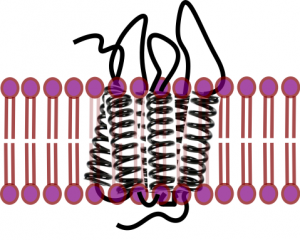Study of the energy landscape of G protein-coupled receptors
PI: Laurent Catoire, co-PI Karine Moncoq
Laboratory of Physical and Chemical Biology of Membrane Proteins
2-year contract
Most hormones and neurotransmitters communicate information to cells via G protein coupled receptors (GPCRs). The large number of biological functions they control also makes these membrane receptors one of the most important families of pharmacological targets in biomedicine. GPCRs are considered to be flexible and dynamic proteins per se, i.e. they can visit several conformational states linked to distinct biological outcomes. Despite a very large number of structures at the atomic scale that are regularly published, these data must be completed to fully understand the function of these complex allosteric machines. The project aims at characterizing the energy landscape of these receptors in complement to low-energy and highly populated published atomic structures by advanced biophysical methods: NMR (kinetic barriers and conformational ensembles), electron cryo-microscopy (structural aspects & conformational ensembles) and single molecule force spectroscopy (kinetics of interactions between ligands and/or effectors with receptors).

Damian et al. (2021) Allosteric modulation of ghrelin receptor signaling by lipids. Nat Commun. 12(1):3938. doi: 10.1038/s41467-021-23756-y
Giusti et al. (2020), Structure of the agonist 12-HHT in its BLT2 receptor-bound state. Sci Rep. 10(1):2630. doi: 10.1038/s41598-020-59571-6.
Casiraghi et al. (2019), NMR analysis of GPCR conformational landscapes and dynamics. Mol Cell Endocrinol. 484:69-77. doi: 10.1016/j.mce.2018.12.019.
Casiraghi et al. (2018) Illuminating the Energy Landscape of GPCRs: The Key Contribution of Solution-State NMR Associated with Escherichia coli as an Expression Host. Biochemistry 57(16):2297-2307. doi: 10.1021/acs.biochem.8b00035.
Chipot et al. (2018) Perturbations of Native Membrane Protein Structure in Alkyl Phosphocholine Detergents: A Critical Assessment of NMR and Biophysical Studies. Chem Rev. 118(7):3559-3607. doi: 10.1021/acs.chemrev.7b00570.
Casiraghi et al. (2016) Functional Modulation of a G Protein-Coupled Receptor Conformational Landscape in a Lipid Bilayer. J Am Chem Soc. 138(35):11170-5. doi: 10.1021/jacs.6b04432
For more information please visit :
http://umr7099.ibpc.fr/research-themes/molecular-signalisation-pathway-of-gpgrs/